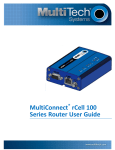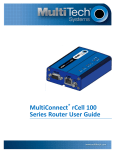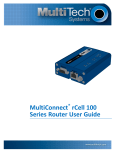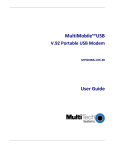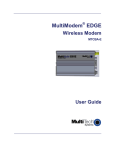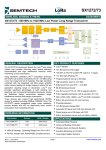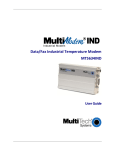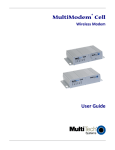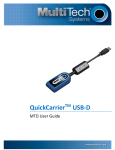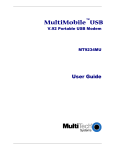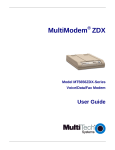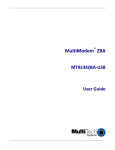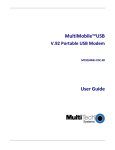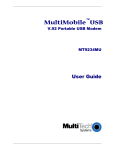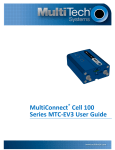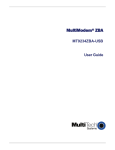Download MultiConnect mDot Developer Guide - Multi
Transcript
MultiConnect® mDotTM MTDOT Developer Guide MULTICONNECT MDOT DEVELOPER GUIDE MultiConnect mDot Developer Guide Models: MTDOT-915-xxx, MTDOT-868-xxx includes also the MTUDK2-ST-MDOT Developer Kit Part Number: S000612, Version 1.2 Copyright This publication may not be reproduced, in whole or in part, without the specific and express prior written permission signed by an executive officer of Multi-Tech Systems, Inc. All rights reserved. Copyright © 2015 by Multi-Tech Systems, Inc. Multi-Tech Systems, Inc. makes no representations or warranties, whether express, implied or by estoppels, with respect to the content, information, material and recommendations herein and specifically disclaims any implied warranties of merchantability, fitness for any particular purpose and noninfringement. Multi-Tech Systems, Inc. reserves the right to revise this publication and to make changes from time to time in the content hereof without obligation of Multi-Tech Systems, Inc. to notify any person or organization of such revisions or changes. Trademarks and Registered Trademarks MultiTech, and the MultiTech logo, and MultiConnect are registered trademarks and mDot and Conduit are a trademark of Multi-Tech Systems, Inc. All other products and technologies are the trademarks or registered trademarks of their respective holders. Legal Notices The MultiTech products are not designed, manufactured or intended for use, and should not be used, or sold or re-sold for use, in connection with applications requiring fail-safe performance or in applications where the failure of the products would reasonably be expected to result in personal injury or death, significant property damage, or serious physical or environmental damage. Examples of such use include life support machines or other life preserving medical devices or systems, air traffic control or aircraft navigation or communications systems, control equipment for nuclear facilities, or missile, nuclear, biological or chemical weapons or other military applications (“Restricted Applications”). Use of the products in such Restricted Applications is at the user’s sole risk and liability. MULTITECH DOES NOT WARRANT THAT THE TRANSMISSION OF DATA BY A PRODUCT OVER A CELLULAR COMMUNICATIONS NETWORK WILL BE UNINTERRUPTED, TIMELY, SECURE OR ERROR FREE, NOR DOES MULTI-TECH WARRANT ANY CONNECTION OR ACCESSIBILITY TO ANY CELLULAR COMMUNICATIONS NETWORK. MULTITECH WILL HAVE NO LIABILITY FOR ANY LOSSES, DAMAGES, OBLIGATIONS, PENALTIES, DEFICIENCIES, LIABILITIES, COSTS OR EXPENSES (INCLUDING WITHOUT LIMITATION REASONABLE ATTORNEYS FEES) RELATED TO TEMPORARY INABILITY TO ACCESS A CELLULAR COMMUNICATIONS NETWORK USING THE PRODUCTS. The MultiTech products and the final application of the MultiTech products should be thoroughly tested to ensure the functionality of the MultiTech products as used in the final application. The designer, manufacturer and reseller has the sole responsibility of ensuring that any end user product into which the MultiTech product is integrated operates as intended and meets its requirements or the requirements of its direct or indirect customers. MultiTech has no responsibility whatsoever for the integration, configuration, testing, validation, verification, installation, upgrade, support or maintenance of such end user product, or for any liabilities, damages, costs or expenses associated therewith, except to the extent agreed upon in a signed written document. To the extent MultiTech provides any comments or suggested changes related to the application of its products, such comments or suggested changes is performed only as a courtesy and without any representation or warranty whatsoever. Contacting MultiTech Knowledge Base The Knowledge Base provides immediate access to support information and resolutions for all MultiTech products. Visit http://www.multitech.com/kb.go. Support Portal To create an account and submit a support case directly to our technical support team, visit: https://support.multitech.com. Support Business Hours: M-F, 8am to 5pm CT Country By Email By Phone Europe, Middle East, Africa: [email protected] +(44) 118 959 7774 U.S., Canada, all others: [email protected] (800) 972-2439 or (763) 717-5863 Warranty To read the warranty statement for your product, visit www.multitech.com/warranty.go. For other warranty options, visit www.multitech.com/es.go. World Headquarters Multi-Tech Systems, Inc. 2205 Woodale Drive, Mounds View, MN 55112 Phone: (800) 328-9717 or (763) 785-3500 Fax (763) 785-9874 2 MultiConnect® mDotTM MTDOT Developer Guide CONTENTS Contents Chapter 1 Product Overview .................................................................................................................................... 6 Overview ....................................................................................................................................................................... 6 Documentation Overview ............................................................................................................................................. 6 Related Documentation .............................................................................................................................................. 6 mbed Documentation ................................................................................................................................................... 6 Programming the mDot Microcontroller .................................................................................................................... 6 mBed Links .................................................................................................................................................................. 7 mDot Platform ........................................................................................................................................................... 7 EUI and Networking ..................................................................................................................................................... 7 Product Build Options ................................................................................................................................................... 8 Chapter 2 Mechanical Drawings with Pinouts .......................................................................................................... 9 MTDOT-xxx-XP1-SMA.................................................................................................................................................... 9 MTDOT-xxx-X1-SMA.................................................................................................................................................... 10 MTDOT-xxx-X1-UFL ..................................................................................................................................................... 11 MTDOT-xxx-M1-UFL.................................................................................................................................................... 12 MTDOT-xxx-M1-TRC.................................................................................................................................................... 13 Chapter 3 Specifications......................................................................................................................................... 14 MTDOT Specifications ................................................................................................................................................. 14 Power Draw................................................................................................................................................................. 15 DC Characteristics ....................................................................................................................................................... 16 Pin Information .......................................................................................................................................................... 16 mDot Pinout Design Notes.......................................................................................................................................... 18 Serial Pinout Notes.................................................................................................................................................... 18 LoRa ............................................................................................................................................................................ 18 Data Rates ................................................................................................................................................................. 18 Range ........................................................................................................................................................................ 18 Chapter 4 Antennas ............................................................................................................................................... 20 Antenna System ......................................................................................................................................................... 20 Pulse Electronics Antenna........................................................................................................................................... 20 Antenna Specifications ............................................................................................................................................. 20 OEM Integration ......................................................................................................................................................... 20 FCC & IC Information to Consumers ......................................................................................................................... 20 FCC Grant Notes........................................................................................................................................................ 20 Host Labeling............................................................................................................................................................. 21 Chapter 5 Safety Information................................................................................................................................. 22 Handling Precautions .................................................................................................................................................. 22 Radio Frequency (RF) Safety ....................................................................................................................................... 22 MultiConnect® mDotTM MTDOT Developer Guide 3 CONTENTS Sécurité relative aux appareils à radiofréquence (RF).............................................................................................. 22 Interference with Pacemakers and Other Medical Devices ...................................................................................... 23 Potential interference ............................................................................................................................................... 23 Precautions for pacemaker wearers ........................................................................................................................ 23 Device Maintenance ................................................................................................................................................... 23 User Responsibility...................................................................................................................................................... 23 Chapter 6 Regulatory Information ......................................................................................................................... 24 EMC, Safety, and R&TTE Directive Compliance ......................................................................................................... 24 47 CFR Part 15 Regulation Class B Devices ................................................................................................................. 24 FCC Interference Notice ............................................................................................................................................. 24 FCC Notice ................................................................................................................................................................... 24 Industry Canada Class B Notice................................................................................................................................... 25 Chapter 7 Environmental Notices........................................................................................................................... 26 Waste Electrical and Electronic Equipment Statement .............................................................................................. 26 WEEE Directive.......................................................................................................................................................... 26 Instructions for Disposal of WEEE by Users in the European Union ........................................................................ 26 REACH Statement ....................................................................................................................................................... 27 Registration of Substances........................................................................................................................................ 27 Substances of Very High Concern (SVHC) ................................................................................................................ 27 Restriction of the Use of Hazardous Substances (RoHS) ............................................................................................ 28 Information on HS/TS Substances According to Chinese Standards ......................................................................... 29 Information on HS/TS Substances According to Chinese Standards (in Chinese) ...................................................... 30 Chapter 8 Labels .................................................................................................................................................... 31 Approvals and Certification......................................................................................................................................... 31 Example Labels............................................................................................................................................................ 31 Chapter 9 Developer Kit Overview ......................................................................................................................... 32 Developer Board Overview ......................................................................................................................................... 32 Features .................................................................................................................................................................... 32 Developer Kit Contents .............................................................................................................................................. 32 Chapter 10 Board Components .............................................................................................................................. 33 Developer Board ........................................................................................................................................................ 33 Developer Board Connectors ...................................................................................................................................... 35 Board Components ..................................................................................................................................................... 35 LED Indicators ............................................................................................................................................................. 36 Chapter 11 Developer Board Installation ............................................................................................................... 37 Installing an mDot on the Developer Board ............................................................................................................... 37 Arduino Shield............................................................................................................................................................. 38 mDot Arduino Pins.................................................................................................................................................... 38 Installing an Arduino Shield with an mDot ............................................................................................................... 38 RSMA to U.FL Cables................................................................................................................................................... 39 4 MultiConnect® mDotTM MTDOT Developer Guide CONTENTS Connecting an Antenna through the Developer Board Connectors........................................................................... 39 Chapter 12 Developer Board Schematics................................................................................................................ 40 Block Diagram ............................................................................................................................................................. 40 Schematics .................................................................................................................................................................. 41 Chapter 13 Design Considerations.......................................................................................................................... 46 Noise Suppression Design ........................................................................................................................................... 46 PC Board Layout Guideline ......................................................................................................................................... 46 User Accessible Areas ............................................................................................................................................... 46 Electromagnetic Interference .................................................................................................................................... 47 Electrostatic Discharge Control................................................................................................................................... 47 USB Design ................................................................................................................................................................. 48 Chapter 14 AT Commands...................................................................................................................................... 49 MultiTech AT Command Set ....................................................................................................................................... 49 General Commands................................................................................................................................................... 49 Network/Addressing Commands .............................................................................................................................. 49 Radio Configuration .................................................................................................................................................. 50 Send/Receive ............................................................................................................................................................ 50 Serial data mode options .......................................................................................................................................... 51 MultiTech Debug....................................................................................................................................................... 51 Standard XBee Zigbee AT Command Set .................................................................................................................... 51 Addressing Commands.............................................................................................................................................. 51 Networking Commands ............................................................................................................................................ 52 Security Commands .................................................................................................................................................. 52 RF Interfacing Commands ......................................................................................................................................... 53 Serial Interfacing Commands .................................................................................................................................... 53 Index...................................................................................................................................................................... 54 MultiConnect® mDotTM MTDOT Developer Guide 5 CHAPTER 1 PRODUCT OVERVIEW Chapter 1 Product Overview Overview The MultiConnect mDot is a secure, programmable, long-range RF module that provides data connectivity to sensors, industrial equipment, and remote appliances. By using the Semtech LoRa™ Long Range Spread Spectrum technology, bi-directional data communication can be maintained over 10 miles/16 km, deep into buildings and within noisy environments using the unlicensed ISM bands in North America, Europe and worldwide. mDot simplifies local connectivity for Internet of Things (IoT) applications. The mDot features an integrated ARM® Cortex®-M4 processor and mbedTM compatible software library for developers to control, monitor and bring edge intelligence to their Internet of Things (IoT) applications. Documentation Overview This manual is one part of mDot documentation. Refer to the Related Documentation and mbed sections for additional information needed to program your mDot and integrate your application with the MultiConnect Conduit gateway. This document includes the following sections: ■ mDot device information: Mechanical drawings, specifications, safety and regulatory information, and other device specific content. Chapters 1-8 ■ Universal Developer Kit information: Using the MTUDK-ST-MDOT Developer Kit, including design considerations, schematics, and installation and operation information. Chapters 9-13 ■ AT commands: Includes both MultiTech and Xbee Zigbee AT Command sets. Chapters 14-15. This manual is available at www.multitech.com/support. Related Documentation Use cases, application notes, LoRa information, and documentation for related products such as the MultiConnect Conduit (MTCDT) gateway and the LoRa accessory card (MTAC-LORA) are available on the MultiTech developer site. This site information on using the Conduit with mDots. Go to: www.multitech.net mbed Documentation ARM mbed is a free, open-source platform and operating system for embedded devices using the ARM Coretx-M microcontrollers. The mbed website provides free software libraries, hardware designs, and online tools for rapid prototyping of products. The platform includes a standards-based C/C++ SDK, a microcontroller HDK, and supported development boards, an online compiler and online developer collaboration tools. Note: To use the mDot mbed code, you need a LoRaWAN 1.0 gateway, such as MultTech's MultiConnect Conduit (MTCDT) with an MTAC-LORA accessory card installed. Programming the mDot Microcontroller With the mDot and the MTUDK2-ST-xx developer board, use the ARM mbed ecosystem to program the microcontroller. Compile in the cloud or locally, copy the resulting binary file to the mbed USB drive, and reset the mDot. 6 MultiConnect® mDotTM MTDOT Developer Guide CHAPTER 1 PRODUCT OVERVIEW Note: To program the mDot, you need an mDot model with programming header. On the mDot mbed page, MultiTech supplies source code for non-RF portions of the mDot and MTAC-LORA cards. To comply with FCC and ETSI certification, some portions of the software will be available only as binary libraries. mBed Links ■ Explore mbed: http://developer.mbed.org/explore ■ Getting Started with mbed: http://developer.mbed.org/getting-started ■ mbed Handbook: http://developer.mbed.org/handbook/Homepage mDot Platform The mDot mbed page includes the mDot library and test cases https://developer.mbed.org/platforms/MTS-mDotF411 EUI and Networking All mDots have a factory-programmed Extended Unique Identifier (EUI). This is marked as Node on the mDot label. To connect an mDot to a network, you will need to program it with the network ID for the network you are connecting to as well as the network key and application key. For information on setting up mDots as part of a LoRa network, go to: www.multitech.net MultiConnect® mDotTM MTDOT Developer Guide 7 CHAPTER 1 PRODUCT OVERVIEW Product Build Options Product Description Quanity to Order MTDOT-915-X1-SMA 915 MHz XBee LoRa SMA 1 or 50 MTDOT-915-X1P-SMA 915 MHz XBee LoRa SMA with Programming Header 1 MTDOT-915-X1-UFL 915 MHz XBee LoRa U.FL 1 or 50 MTDOT-915-M1-UFL 915 MHz SMT LoRa U.FL 1 or 100 MTDOT-915-M1-TRC 915 MHz SMT LoRa RF Pad 1 or 100 MTDOT-868-X1-SMA 868 MHz XBee LoRa SMA 1 or 50 MDOT-868-X1P-SMA 868 MHz XBee LoRa SMA with Programming Header 1 MTDOT-868-X1-UFL 868 MHz XBee LoRa U.FL 1 or 50 MTDOT-868-M1-UFL 868 MHz SMT LoRa U.FL 1 or 100 MTDOT-868-M1-TRC 868 MHz SMT LoRa RF Pad 1 or 100 mDot Developer Kit 1 North America EMEA Developer Kits MTUDK2-ST-MDOT Note: ■ The complete product code may end in .Rx. For example, MTDOT-915-M1-X1.Rx, where R is revision and x is the revision number. 8 MultiConnect® mDotTM MTDOT Developer Guide CHAPTER 2 MECHANICAL DRAWINGS WITH PINOUTS Chapter 2 Mechanical Drawings with Pinouts MTDOT-xxx-XP1-SMA MultiConnect® mDotTM MTDOT Developer Guide 9 CHAPTER 2 MECHANICAL DRAWINGS WITH PINOUTS MTDOT-xxx-X1-SMA 10 MultiConnect® mDotTM MTDOT Developer Guide CHAPTER 2 MECHANICAL DRAWINGS WITH PINOUTS MTDOT-xxx-X1-UFL MultiConnect® mDotTM MTDOT Developer Guide 11 CHAPTER 2 MECHANICAL DRAWINGS WITH PINOUTS MTDOT-xxx-M1-UFL 12 MultiConnect® mDotTM MTDOT Developer Guide CHAPTER 2 MECHANICAL DRAWINGS WITH PINOUTS MTDOT-xxx-M1-TRC MultiConnect® mDotTM MTDOT Developer Guide 13 CHAPTER 3 SPECIFICATIONS Chapter 3 Specifications MTDOT Specifications Category Description General Compatibility LoRaWAN 1.0 specifications Interfaces Note that pin functions are multiplexed. Up to 16 digital I/O Up to 11 analog inputs SPI I2C UART (RX, TX, RTS, CTS) USB (OTG full speed) CPU Performance CPU STM32 Max Clock 100 MHz (configurable to control power use) Flash Memory 512 KB (400 KB available) RAM 128 KB Radio Frequency ISM Bands 863 MHz - 868 MHz, 902 MHz - 928 MHz Physical Description Weight1 0.2 oz. (5g) Dimensions Refer to Mechanical Drawings for Dimensions. Connectors -SMA Models SMA -UFL Models U.FL -Trace Models Trace Connection Environment Operating Temperature -40° C to +85° C Storage Temperature -40° C to +85° C Humidity 20%-90% RH, non-condensing Power Requirements 14 Operating Voltage 3.3 V Input Power 3.3 VDC MultiConnect® mDotTM MTDOT Developer Guide CHAPTER 3 SPECIFICATIONS Category Description Transmission North America EMEA Max Transmitter Power Output (TPO) 15 dBm 14 dBm Maximum Receive Sensitivity -130 dBm -137 dBm Link Budget2 154 dB Point-to-Multipoint3, 147 dB Point-to-Point 145 dB Point-to-Multipoint, 147 dB Point-toPoint Max Effective Isotropic Radiated Power (EiRP) 36 dBm 10 dBm Certifications and Compliance EMC Compliance EN 300 220-2 V2.4.1:2012 EN 301 489-03 V1.6.1:2013 Radio Compliance FCC 15.247:2015 FCC 15.109:2015 FCC 15.107:2015 RSS-210:2010 ICES-003:2012 CISPR 22:2008 EN 300 220-2 V2.4.1:2012 Safety Compliance UL 60950-1 2nd ED cUL 60950-1 2nd ED IEC 60950-1 2nd ED AM1 + AM2 1 Weight is for the MTDOT-xxx-X1P-SMA, which is the heaviest model. 2 Greater link budget is possible with higher gain antenna. 3 Point-to-Multipoint using MultiTech Gateway with MT-LORA accessory card Power Draw Note: ■ Power measured with the mDot installed on the MTUDK2 developer board. MTUDK2 supplied 3.3 VDC to the mDot. ■ Power measured with mDot spreading factor (SF) set to 9. MultiConnect® mDotTM MTDOT Developer Guide 15 CHAPTER 3 SPECIFICATIONS ■ Transmit power measured with mDot transmitting to a MultiConnect Conduit with an MTAC-LORA accessory card installed. Distance separating the Conduit from the mDot was 18 inches. Voltage Packet Size Average Current (Amps) at Low Transmit Power Setting (TXP 2) Average Current (Amps) at Default Transmit Power Setting (TXP 11) Total Inrush Charge Measured in Millicoulombs (mC) Total Inrush Charge Duration during Powerup (mS) 3.3 10 0.019 0.020 2.15 1.098 230 0.029 0.029 2.15 1.098 DC Characteristics Signal Description Min Max Vin Low Input low level -- .99 Vin High Input high level 2.31 -- Vout Low Output low level -- .4 Vout High Output high level 2.9 -- VCC Standard operating voltage 3.3 5 ICC1 Operating current (mA) @5V -- 135 Operating current (mA) @3.3V -- 200 Pin Information Using the mbed platform with the Cortex-M4 processor expands your pin functionality options. Refer to the document, mDot Pin Function Mapping, which is available at www.multitech.net/developer/multiconnect-mdot and https://developer.mbed.org/platforms/MTS-mdot-f411/ for details. MT Pin Base Description Number (Where applicabl e) 1 3.3 to 5 V input 2 PA2 Dout 3 PA3 Din 4 PA6 D08/MISO 5 6 16 nReset PA8 PWM0/RSSI/CSC L MultiConnect® mDotTM MTDOT Developer Guide CHAPTER 3 SPECIFICATIONS MT Pin Base Description Number (Where applicabl e) 7 PA9 8 9 PWM1/12CSDA Reserved PA11 10 nDTR/SleepRQ/D 18 Ground 11 PA7 AD4/DIO4/MOSI 12 PA0 nCTS/DIO7 13 PC13 ON/Sleep 14 No connect 15 PC1 Associate/AD5/D IO5 16 PA1 AD6/DIO6/RTS 17 PA4 AD3/DIO3/SNSS 18 PA5 AD2/DIO3/SCLK 19 PB0 AD1/DIO1 20 PB1 AD0/DIO0 21 Ground 22 RF 23 Ground 24 3.3V output 25 Ground 26 JTAG-SWCLK 27 JTAG-SWIO 28 JTAG-nRST 29 JTAG-SWO 30 PA10 Debug RX 31 PA9 Debug TX MultiConnect® mDotTM MTDOT Developer Guide 17 CHAPTER 3 SPECIFICATIONS mDot Pinout Design Notes Refer to the mechanical drawing for your model for pin locations. ■ All pins that go to connectors are direct connect. ■ Reset is the only pin with pull up. ■ I/O is 5V tolerant. mDots allow you to program pins depending on your application: ■ Serial: Available out of the box. See Serial Pinout Notes for details. ■ Xbee: Comforms to the Xbee pinout. ■ mbed: Designed with the mbed STM32F411 RET 64-pin processor, this option provides the most flexibility. For more information about processor capabilities, see the STM32F411 RET datasheet. Note: To program the mDot, you need an mDot model with programming header. Serial Pinout Notes Out of the box, these pins are available for serial applications. Refer to the mechanical drawing for your model for pin locations. ■ 2 Dout/TX ■ 3 Din/RX ■ 9 DTR ■ 12 CTS ■ 13 On/Sleep ■ 16 RTS LoRa Data Rates Theoretical maximum speeds for LoRa mode with ACKs off are: ■ Using spreading factor 7 at 125kHz5, the data rate is 5470 bps (5.47 kbps). ■ Using spreading factor 7 at 500kHz the data rate is 21900 bps (21.9 kbps). Range Variables effecting the mDot range include TX power, antenna gain, RX sensitivity, fade margin, earth's curvature. Use the following formula to calculate the maximum range: The following table provides example settings and the theoretical maximum range based on these settings. 18 Example 18dB Transmit Power for 915 MHz Models Units Example 14dB Transmit Power for 868MHz Models Frequency 915 MHz 868 MultiConnect® mDotTM MTDOT Developer Guide CHAPTER 3 SPECIFICATIONS Example 18dB Transmit Power for 915 MHz Models Units Example 14dB Transmit Power for 868MHz Models TX Power 18 dBm 14 TX Antenna Gain 3 dB 3 RX Sensitivity -120 dBm -120 RX Antenna Gain 3 dB 3 Fade Margin 30 dB 30 Distance 8.14 Miles 5.41 Distance 13.08 Km 8.70 MultiConnect® mDotTM MTDOT Developer Guide 19 CHAPTER 4 ANTENNAS Chapter 4 Antennas Antenna System The LoRa antenna performance depends on the implementation and antenna design. The integration of the antenna system into the product is a critical part of the design process; therefore, it is essential to consider it early so the performance is not compromised. If changes are made to the device's certified antenna system, then recertification will be required. Pulse Electronics Antenna Manufacturer: Pulse Electronics Description: 868-915 MHz RP-SMA Antenna, 8" Model Number: W1063 MultiTech Part Number: 45009830L MultiTech ordering information: Ordering Part Number Quantity AN868-915A-1HRA 1 AN868-915A-10HRA 10 AN868-915A-50HRA 50 Antenna Specifications Category Description Frequency Range 868-928 MHz Impedance 50 Ohms VSWR < 2.0 Gain 3.0 dBi Radiation Omni Polarization Vertical OEM Integration FCC & IC Information to Consumers The user manual for the consumer must contain the statements required by the following FCC and IC regulations: 47 C.F.R. 15.19(a)(3), 15.21, 15.105 and RSS-Gen Issue 3, Dec 2010; 7.1.2 and 7.1.3 FCC Grant Notes The OEM should follow all the grant notes listed below. Otherwise, further testing and device approvals may be necessary. 20 MultiConnect® mDotTM MTDOT Developer Guide CHAPTER 4 ANTENNAS FCC Definitions Portable: (§2.1093) — A portable device is defined as a transmitting device designed to be used so that the radiating structure(s) of the device is/are within 20 centimeters of the body of the user. Mobile: (§2.1091) — A mobile device is defined as a transmitting device designed to be used in other than fixed locations and to generally be used in such a way that a separation distance of at least 20 centimeters is normally maintained between the transmitter’s radiating structure(s) and the body of the user or nearby persons. Actual content pending Grant: This device is a mobile device with respect to RF exposure compliance. The antenna(s) used for this transmitter must be installed to provide a separation distance of at least 20 cm from all persons, and must not be collocated or operate in conjunction with any other antenna or transmitter except in accordance with FCC multi-transmitter product guidelines. Installers and end-users must be provided with specific information required to satisfy RF exposure compliance for installations and final host devices. (See note under Grant Limitations.) Compliance of this device in all final host configurations is the responsibility of the Grantee. Note: Host design configurations constituting a device for portable use (<20 cm from human body) require separate FCC/IC approval. Host Labeling The following statements are required to be on the host label: This device contains FCC ID: {Add the FCC ID of the specific device} This device contains equipment certified under IC ID: {Add the IC ID of the specific device} For additional labeling requirements, see the product's Labeling Requirements. For the FCC and IC IDs, see specific certificate information in the Regulatory Statement chapter. MultiConnect® mDotTM MTDOT Developer Guide 21 CHAPTER 5 SAFETY INFORMATION Chapter 5 Safety Information Handling Precautions To avoid damage due to the accumulation of static charge, use proper precautions when handling any cellular device. Although input protection circuitry has been incorporated into the devices to minimize the effect of static build-up, use proper precautions to avoid exposure to electronic discharge during handling and mounting the device. Radio Frequency (RF) Safety Due to the possibility of radio frequency (RF) interference, it is important that you follow any special regulations regarding the use of radio equipment. Follow the safety advice given below. ■ Operating your device close to other electronic equipment may cause interference if the equipment is inadequately protected. Observe any warning signs and manufacturers’ recommendations. ■ Different industries and businesses restrict the use of cellular devices. Respect restrictions on the use of radio equipment in fuel depots, chemical plants, or where blasting operations are in process. Follow restrictions for any environment where you operate the device. ■ Do not place the antenna outdoors. ■ Switch OFF your wireless device when in an aircraft. Using portable electronic devices in an aircraft may endanger aircraft operation, disrupt the cellular network, and is illegal. Failing to observe this restriction may lead to suspension or denial of cellular services to the offender, legal action, or both. ■ Switch OFF your wireless device when around gasoline or diesel-fuel pumps and before filling your vehicle with fuel. ■ Switch OFF your wireless device in hospitals and any other place where medical equipment may be in use. Sécurité relative aux appareils à radiofréquence (RF) À cause du risque d'interférences de radiofréquence (RF), il est important de respecter toutes les réglementations spéciales relatives aux équipements radio. Suivez les conseils de sécurité ci-dessous. ■ Utiliser l'appareil à proximité d'autres équipements électroniques peut causer des interférences si les équipements ne sont pas bien protégés. Respectez tous les panneaux d'avertissement et les recommandations du fabricant. ■ Certains secteurs industriels et certaines entreprises limitent l'utilisation des appareils cellulaires. Respectez ces restrictions relatives aux équipements radio dans les dépôts de carburant, dans les usines de produits chimiques, ou dans les zones où des dynamitages sont en cours. Suivez les restrictions relatives à chaque type d'environnement où vous utiliserez l'appareil. ■ Ne placez pas l'antenne en extérieur. ■ Éteignez votre appareil sans fil dans les avions. L'utilisation d'appareils électroniques portables en avion est illégale: elle peut fortement perturber le fonctionnement de l'appareil et désactiver le réseau cellulaire. S'il ne respecte pas cette consigne, le responsable peut voir son accès aux services cellulaires suspendu ou interdit, peut être poursuivi en justice, ou les deux. ■ Éteignez votre appareil sans fil à proximité des pompes à essence ou de diesel avant de remplir le réservoir de votre véhicule de carburant. 22 MultiConnect® mDotTM MTDOT Developer Guide CHAPTER 5 SAFETY INFORMATION ■ Éteignez votre appareil sans fil dans les hôpitaux ou dans toutes les zones où des appareils médicaux sont susceptibles d'être utilisés. Interference with Pacemakers and Other Medical Devices Potential interference Radiofrequency energy (RF) from cellular devices can interact with some electronic devices. This is electromagnetic interference (EMI). The FDA helped develop a detailed test method to measure EMI of implanted cardiac pacemakers and defibrillators from cellular devices. This test method is part of the Association for the Advancement of Medical Instrumentation (AAMI) standard. This standard allows manufacturers to ensure that cardiac pacemakers and defibrillators are safe from cellular device EMI. The FDA continues to monitor cellular devices for interactions with other medical devices. If harmful interference occurs, the FDA will assess the interference and work to resolve the problem. Precautions for pacemaker wearers If EMI occurs, it could affect a pacemaker in one of three ways: ■ Stop the pacemaker from delivering the stimulating pulses that regulate the heart's rhythm. ■ Cause the pacemaker to deliver the pulses irregularly. ■ Cause the pacemaker to ignore the heart's own rhythm and deliver pulses at a fixed rate. Based on current research, cellular devices do not pose a significant health problem for most pacemaker wearers. However, people with pacemakers may want to take simple precautions to be sure that their device doesn't cause a problem. ■ Keep the device on the opposite the side of the body from the pacemaker to add extra distance between the pacemaker and the device. ■ Avoid placing a turned-on device next to the pacemaker (for example, don’t carry the device in a shirt or jacket pocket directly over the pacemaker). Device Maintenance When maintaining your device: ■ Do not attempt to disassemble the device. There are no user serviceable parts inside. ■ Do not expose your device to any extreme environment where the temperature or humidity is high. ■ Do not expose the device to water, rain, or spilled beverages. It is not waterproof. ■ Do not place the device alongside computer discs, credit or travel cards, or other magnetic media. The information contained on discs or cards may be affected by the device. ■ Using accessories, such as antennas, that MultiTech has not authorized or that are not compliant with MultiTech's accessory specifications may invalidate the warranty. If the device is not working properly, contact MultiTech Technical Support. User Responsibility Respect all local regulations for operating your wireless device. Use the security features to block unauthorized use and theft. MultiConnect® mDotTM MTDOT Developer Guide 23 CHAPTER 6 REGULATORY INFORMATION Chapter 6 Regulatory Information EMC, Safety, and R&TTE Directive Compliance The CE mark is affixed to this product to confirm compliance with the following European Community Directives: Council Directive 2004/108/EC of 15 December 2004 on the approximation of the laws of Member States relating to electromagnetic compatibility; and Council Directive 2006/95/EC of 12 December 2006 on the harmonization of the laws of Member States relating to electrical equipment designed for use within certain voltage limits; and Council Directive 2011/65/EU on the restriction of the use of certain hazardous substances in electrical and electronic equipment; and Council Directive 1999/5/EC of 9 March 1999 on radio equipment and telecommunications terminal equipment and the mutual recognition of their conformity. 47 CFR Part 15 Regulation Class B Devices This equipment has been tested and found to comply with the limits for a Class B digital device, pursuant to part 15 of the FCC Rules. These limits are designed to provide reasonable protection against harmful interference in a residential installation. This equipment generates, uses, and can radiate radio frequency energy and, if not installed and used in accordance with the instructions, may cause harmful interference to radio communications. However, there is no guarantee that interference will not occur in a particular installation. If this equipment does cause harmful interference to radio or television reception, which can be determined by turning the equipment off and on, the user is encouraged to try to correct the interference by one or more of the following measures: ■ Reorient or relocate the receiving antenna. ■ Increase the separation between the equipment and receiver. ■ Connect the equipment into an outlet on a circuit different from that to which the receiver is connected. ■ Consult the dealer or an experienced radio/TV technician for help. Warning: Changes or modifications to this unit not expressly approved by the party responsible for compliance could void the user’s authority to operate the equipment. FCC Interference Notice Per FCC 15.19(a)(3) and (a)(4) This device complies with part 15 of the FCC Rules. Operation is subject to the following two conditions: (1) This device may not cause harmful interference, and (2) this device must accept any interference received, including interference that may cause undesired operation. FCC Notice The MTDOT-x family of products are open development based products that contain a sub ghz radio technology. MultiTech has certified for compliance with US and Foreign compliance bodies including FCC, R&TTE and others. (e.g. FCC 15.247:2015 & IC RSS-210:2010) 24 MultiConnect® mDotTM MTDOT Developer Guide CHAPTER 6 REGULATORY INFORMATION MultiTech provides software code meant to operate the radio to a level that maintains compliance with the operating modes under which these radio devices were certified. To ensure this level of compliance, the software code is provided in binary form only. Users are prohibited from making any changes that affect the operation of the radio performance. Accessing or controlling the radio through any means other than the provided binary software will require the user to obtain their own intentional radiator license from the certification body governing their locality, as all precertification provided with mDot will have been made invalid. Industry Canada Class B Notice This Class B digital apparatus meets all requirements of the Canadian Interference-Causing Equipment Regulations. Cet appareil numérique de la classe B respecte toutes les exigences du Reglement Canadien sur le matériel brouilleur. This device complies with Industry Canada RSS Appliance radio exempt from licensing. The operation is permitted for the following two conditions: 1. 2. the device may not cause harmful interference, and the user of the device must accept any interference suffered, even if the interference is likely to jeopardize the operation. Le présent appareil est conforme aux CNR d'Industrie Canada applicables aux appareils radio exempts de licence. L'exploitation est autorisée aux deux conditions suivantes: 1. 2. l'appareil ne doit pas produire de brouillage, et l'utilisateur de l'appareil doit accepter tout brouillage radioélectrique subi, même si le brouillage est susceptible d'en compromettre le fonctionnement. MultiConnect® mDotTM MTDOT Developer Guide 25 CHAPTER 7 ENVIRONMENTAL NOTICES Chapter 7 Environmental Notices Waste Electrical and Electronic Equipment Statement Note: This statement may be used in documentation for your final product applications. WEEE Directive The WEEE Directive places an obligation on EU-based manufacturers, distributors, retailers, and importers to takeback electronics products at the end of their useful life. A sister directive, ROHS (Restriction of Hazardous Substances) complements the WEEE Directive by banning the presence of specific hazardous substances in the products at the design phase. The WEEE Directive covers all MultiTech products imported into the EU as of August 13, 2005. EU-based manufacturers, distributors, retailers and importers are obliged to finance the costs of recovery from municipal collection points, reuse, and recycling of specified percentages per the WEEE requirements. Instructions for Disposal of WEEE by Users in the European Union The symbol shown below is on the product or on its packaging, which indicates that this product must not be disposed of with other waste. Instead, it is the user's responsibility to dispose of their waste equipment by handing it over to a designated collection point for the recycling of waste electrical and electronic equipment. The separate collection and recycling of your waste equipment at the time of disposal will help to conserve natural resources and ensure that it is recycled in a manner that protects human health and the environment. For more information about where you can drop off your waste equipment for recycling, please contact your local city office, your household waste disposal service or where you purchased the product. July, 2005 26 MultiConnect® mDotTM MTDOT Developer Guide CHAPTER 7 ENVIRONMENTAL NOTICES REACH Statement Registration of Substances After careful review of the legislation and specifically the definition of an “article” as defined in EC Regulation 1907/2006, Title II, Chapter 1, Article 7.1(a)(b), it is our current view Multi-Tech Systems, Inc. products would be considered as “articles”. In light of the definition in § 7.1(b) which requires registration of an article only if it contains a regulated substance that “is intended to be released under normal or reasonably foreseeable conditions of use,” Our analysis is that Multi-Tech Systems, Inc. products constitute nonregisterable articles for their intended and anticipated use. Substances of Very High Concern (SVHC) Per the candidate list of Substances of Very High Concern (SVHC) published October 28, 2008 we have reviewed these substances and certify the Multi-Tech Systems, Inc. products are compliant per the EU “REACH” requirements of less than 0.1% (w/w) for each substance. If new SVHC candidates are published by the European Chemicals Agency, and relevant substances have been confirmed, that exceeds greater than 0.1% (w/w), MultiTech Systems, Inc. will provide updated compliance status. Multi-Tech Systems, Inc. also declares it has been duly diligent in ensuring that the products supplied are compliant through a formalized process which includes collection and validation of materials declarations and selective materials analysis where appropriate. This data is controlled as part of a formal quality system and will be made available upon request. MultiConnect® mDotTM MTDOT Developer Guide 27 CHAPTER 7 ENVIRONMENTAL NOTICES Restriction of the Use of Hazardous Substances (RoHS) Multi-Tech Systems, Inc. Certificate of Compliance 2011/65/EU Multi-Tech Systems, Inc. confirms that its embedded products comply with the chemical concentration limitations set forth in the directive 2011/65/EU of the European Parliament (Restriction of the use of certain Hazardous Substances in electrical and electronic equipment - RoHS). These MultiTech products do not contain the following banned chemicals1: ■ Lead, [Pb] < 1000 PPM ■ Mercury, [Hg] < 1000 PPM ■ Hexavalent Chromium, [Cr+6] < 1000 PPM ■ Cadmium, [Cd] < 100 PPM ■ Polybrominated Biphenyl, [PBB] < 1000 PPM ■ Polybrominated Diphenyl Ether, [PBDE] < 1000 PPM Environmental considerations: ■ Moisture Sensitivity Level (MSL) =1 ■ Maximum Soldering temperature = 260C (in SMT reflow oven) 1 Lead usage in some components is exempted by the following RoHS annex, therefore higher lead concentration would be found in some modules (>1000 PPM); - Resistors containing lead in a glass or ceramic matrix compound. 28 MultiConnect® mDotTM MTDOT Developer Guide CHAPTER 7 ENVIRONMENTAL NOTICES Information on HS/TS Substances According to Chinese Standards In accordance with China's Administrative Measures on the Control of Pollution Caused by Electronic Information Products (EIP) # 39, also known as China RoHS, the following information is provided regarding the names and concentration levels of Toxic Substances (TS) or Hazardous Substances (HS) which may be contained in Multi-Tech Systems Inc. products relative to the EIP standards set by China's Ministry of Information Industry (MII). Hazardous/Toxic Substance/Elements Name of the Component Lead (PB) Mercury (Hg) Cadmium Hexavalent (CD) Chromium (CR6+) Polybromi Polybrominat nated ed Diphenyl Biphenyl Ether (PBDE) (PBB) Printed Circuit Boards O O O O O O Resistors X O O O O O Capacitors X O O O O O Ferrite Beads O O O O O O Relays/Opticals O O O O O O ICs O O O O O O Diodes/ Transistors O O O O O O Oscillators and Crystals X O O O O O Regulator O O O O O O Voltage Sensor O O O O O O Transformer O O O O O O Speaker O O O O O O Connectors O O O O O O LEDs O O O O O O Screws, Nuts, and other Hardware X O O O O O AC-DC Power Supplies O O O O O O Software /Documentation CDs O O O O O O Booklets and Paperwork O O O O O O Chassis O O O O O O X Represents that the concentration of such hazardous/toxic substance in all the units of homogeneous material of such component is higher than the SJ/Txxx-2006 Requirements for Concentration Limits. O Represents that no such substances are used or that the concentration is within the aforementioned limits. MultiConnect® mDotTM MTDOT Developer Guide 29 CHAPTER 7 ENVIRONMENTAL NOTICES Information on HS/TS Substances According to Chinese Standards (in Chinese) 依照中国标准的有毒有害物质信息 根据中华人民共和国信息产业部 (MII) 制定的电子信息产品 (EIP) 标准-中华人民共和国《电子信息产品污染控制管理办法》(第 39 号),也称作中国 RoHS, 下表列出了 Multi-Tech Systems, Inc. 产品中可能含有的有毒物质 (TS) 或有害物质 (HS) 的名称及含量水平方面的信息。 有害/有毒物质/元素 成分名称 铅 (PB) 汞 (Hg) 镉 (CD) 六价铬 (CR6+) 多溴联苯 (PBB) 多溴二苯醚 (PBDE) 印刷电路板 O O O O O O 电阻器 X O O O O O 电容器 X O O O O O 铁氧体磁环 O O O O O O 继电器/光学部件 O O O O O O ICs O O O O O O 二极管/晶体管 O O O O O O 振荡器和晶振 X O O O O O 调节器 O O O O O O 电压传感器 O O O O O O 变压器 O O O O O O 扬声器 O O O O O O 连接器 O O O O O O LEDs O O O O O O 螺丝、螺母以及其它五金件 X O O O O O 交流-直流电源 O O O O O O 软件/文档 CD O O O O O O 手册和纸页 O O O O O O 底盘 O O O O O O X 表示所有使用类似材料的设备中有害/有毒物质的含量水平高于 SJ/Txxx-2006 限量要求。 O 表示不含该物质或者该物质的含量水平在上述限量要求之内。 30 MultiConnect® mDotTM MTDOT Developer Guide CHAPTER 8 LABELS Chapter 8 Labels Approvals and Certification In most cases, when integrated and used with an antenna system that was part of the MultiTech modem certification, additional approvals or certifications are not required for the device you develop as long as the following are met. ■ PTCRB Requirements: The antenna system cannot be altered. ■ Model Identification: The MultiTech model identification allows the carrier to verify the modem as one of its approved models. This information is located on the modem's label below the bar code. Example Labels Note: Actual labels vary depending on the regulatory approval markings and content. This device complies with part 15 of the FCC Rules. Operation is subject to the following two conditions: (1) This device may not cause harmful interference, and (2) this device must accept any interference received, including interference that may cause undesired operation. The label shown is not than actual size. 1 - MultiTech Model Identification. 2 - MultiTech Ordering Part Number. 3 - Device Node Number. Example North America Package Label North America Device Label MultiConnect® mDotTM MTDOT Developer Guide Example EMEA Package Label EMEA Device Label 31 CHAPTER 9 DEVELOPER KIT OVERVIEW Chapter 9 Developer Kit Overview Developer Board Overview The MTUDK2-ST-MDOT Developer Kit supports development with mDot devices. Use the developer board to streamline your development efforts and evaluate your products and applications. Easily plug in your communications device and use the developer kit for testing, programming and evaluation. Note: The MTUDK2-ST-Cell Developer Kit is also compatible with mDot devices. Developer information in this section applies to either of these developer board models when used with mDots. (The MTUDK2-ST-Cell model includes additional components which are used to develop with other devices.) Features ■ USB and serial interfaces ■ USB port for mbed development environment ■ RS-232 DB-9 connector for serial interface ■ Arduino shield socket Developer Kit Contents Your Developer Kit (MTUDK2-ST-MDOT) includes the following: Developer Board 1 - MTUDK 2.0 mDot Developer Board Cables 1 - Micro USB Cable 1 - RSMA-U.FL Antenna Cables (attached to developer board) 32 Antennas 1 - 868-945 MHz Antenna Customer Notices Quick Start Additional One promotional screwdriver MultiConnect® mDotTM MTDOT Developer Guide CHAPTER 10 BOARD COMPONENTS Chapter 10 Board Components Developer Board MultiConnect® mDotTM MTDOT Developer Guide 33 CHAPTER 10 BOARD COMPONENTS 34 MultiConnect® mDotTM MTDOT Developer Guide CHAPTER 10 BOARD COMPONENTS Developer Board Connectors Board Components Label Description J4 RS232 DB-9 Serial Connector J6 mbed USB Connector JP98 Serial Disconnect Header JP197 J-Link Header S1 Reset Button X6 Arduino Shield Connector X7 Arduino Shield Connector MultiConnect® mDotTM MTDOT Developer Guide 35 CHAPTER 10 BOARD COMPONENTS Label Description X8 Arduino Shield Connector X9 Arduino Shield Connector X10 MTDOT Connector X11 MTDOT Connector J12 MTDOT Programming Header LED Indicators 36 Label LED Location STAT LED1 Same side as RS-232 DB-9 connector COM LED2 Same side as RS-232 DB-9 connector D7 LED3 Across the mDot connectors. D6 LED7 Directly across from the mDot connectors. D3 LED8 Directly across from the mDot connectors. D0 LED9 Directly across from the mDot connectors. D1 LED10 Directly across from the mDot connectors. RST LED12 Directly across from the mDot connectors. PWR LED13 Directly across from the mDot connectors. D2 LED14 Directly across from the mDot connectors. MultiConnect® mDotTM MTDOT Developer Guide CHAPTER 11 DEVELOPER BOARD INSTALLATION Chapter 11 Developer Board Installation Installing an mDot on the Developer Board To install an mDot on the Developer Board: 1. Align the mDot with the developer board as shown. 2. Gently press the mDot into the connectors. MultiConnect® mDotTM MTDOT Developer Guide 37 CHAPTER 11 DEVELOPER BOARD INSTALLATION Arduino Shield mDot Arduino Pins Installing an Arduino Shield with an mDot Note: When using an Arduino Shield with an mDot, install the mDot on the developer board before installing the Arduino shield. To use an Arduino Shield with an mDot: 1. Disable the developer card’s serial port by removing jumper from JP95. ■ Jumper pins 1-2: Disable U5 on USB VCC high. ■ Jumper pins 2-3: U5 always disabled. ■ Default jumper position is on pins 1-2. 2. 38 Align the Arduino Shield on the developer board as shown. MultiConnect® mDotTM MTDOT Developer Guide CHAPTER 11 DEVELOPER BOARD INSTALLATION RSMA to U.FL Cables The developer kit includes one 4.5" RSMA to U.FL cables which is preinstalled on the developer board. Connecting an Antenna through the Developer Board Connectors Depending on the mDot model, either connect the antenna directly to the mDot or through the RSMA-to-U.FL antenna cable on the developer board. To connect an antenna to the device through the developer board : 1. 2. Finger tighten the antenna to the SMA connector. Attach the U.FL connector from the cable to the connector on the device. MultiConnect® mDotTM MTDOT Developer Guide 39 CHAPTER 12 DEVELOPER BOARD SCHEMATICS Chapter 12 Developer Board Schematics Block Diagram 40 MultiConnect® mDotTM MTDOT Developer Guide CHAPTER 12 DEVELOPER BOARD SCHEMATICS Schematics MultiConnect® mDotTM MTDOT Developer Guide 41 CHAPTER 12 DEVELOPER BOARD SCHEMATICS 42 MultiConnect® mDotTM MTDOT Developer Guide CHAPTER 12 DEVELOPER BOARD SCHEMATICS MultiConnect® mDotTM MTDOT Developer Guide 43 CHAPTER 12 DEVELOPER BOARD SCHEMATICS 44 MultiConnect® mDotTM MTDOT Developer Guide CHAPTER 12 DEVELOPER BOARD SCHEMATICS MultiConnect® mDotTM MTDOT Developer Guide 45 CHAPTER 13 DESIGN CONSIDERATIONS Chapter 13 Design Considerations Noise Suppression Design Adhere to engineering noise-suppression practices when designing a printed circuit board (PCB). Noise suppression is essential to the proper operation and performance of the modem and surrounding equipment. Any OEM board design must consider both on-board and off-board generated noise that can affect digital signal processing. Both on-board and off-board generated noise that is coupled on-board can affect interface signal levels and quality. Noise in frequency ranges that affect modem performance is of particular concern. On-board generated electromagnetic interference (EMI) noise that can be radiated or conducted off-board is equally important. This type of noise can affect the operation of surrounding equipment. Most local government agencies have certification requirements that must be met for use in specific environments. Proper PC board layout (component placement, signal routing, trace thickness and geometry, and so on) component selection (composition, value, and tolerance), interface connections, and shielding are required for the board design to achieve desired modem performance and to attain EMI certification. Other aspects of proper noise-suppression engineering practices are beyond the scope of this guide. Consult noise suppression techniques described in technical publications and journals, electronics and electrical engineering text books, and component supplier application notes. PC Board Layout Guideline In a 4-layer design, provide adequate ground plane covering the entire board. In 4-layer designs, power and ground are typically on the inner layers. Ensure that all power and ground traces are 0.05 inches wide. The recommended hole size for the device pins is 0.036 in. +/-0.003 in. in diameter. Use spacers to hold the device vertically in place during the wave solder process. All creepages and clearances for the device meet requirements of safety standards listed in the technical specifications. The requirements are based on a working voltage of 125V or 250V. When implementing the recommended DAA* circuit interface in a third party design, strictly follow all creepage and clearance requirements to meet safety standards. The third party safety design must be evaluated by the appropriate national agency according to the required specification. User Accessible Areas Based on where the third party design is marketed, sold, or used, it may be necessary to provide an insulating cover over all TNV exposed areas. Consult with the recognized safety agency to determine the requirements. Note: Even if the recommended design considerations are followed, there are no guarantees that a particular system complies with all the necessary regulatory requirements. Make sure a qualified and recognized agency evaluates specific designs. . *DAA stands for Data Access Arrangement. DAA is the device's telephone line interface. 46 MultiConnect® mDotTM MTDOT Developer Guide CHAPTER 13 DESIGN CONSIDERATIONS Electromagnetic Interference The following guidelines are offered specifically to help minimize EMI generation. Some of these guidelines are the same as, or similar to, the general guidelines. To minimize the contribution of device-based design to EMI, you must understand the major sources of EMI and how to reduce them to acceptable levels. ■ Keep traces carrying high frequency signals as short as possible. ■ Provide a good ground plane or grid. In some cases, a multilayer board may be required with full layers for ground and power distribution. ■ Decouple power from ground with decoupling capacitors as close to the device's power pins as possible. ■ Eliminate ground loops, which are unexpected current return paths to the power source and ground. ■ Decouple the telephone line cables at the telephone line jacks. Typically, use a combination of series inductors, common mode chokes, and shunt capacitors. Methods to decouple telephone lines are similar to decoupling power lines; however, telephone line decoupling may be more difficult and deserves additional attention. A commonly used design aid is to place footprints for these components and populate as necessary during performance/EMI testing and certification. ■ Decouple the power cord at the power cord interface with decoupling capacitors. Methods to decouple power lines are similar to decoupling telephone lines. ■ Locate high frequency circuits in a separate area to minimize capacitive coupling to other circuits. ■ Locate cables and connectors to avoid coupling from high frequency circuits. ■ Lay out the highest frequency signal traces next to the ground grid. ■ If using a multilayer board design, make no cuts in the ground or power planes and be sure the ground plane covers all traces. ■ Minimize the number of through-hole connections on traces carrying high frequency signals. ■ Avoid right angle turns on high frequency traces. Forty-five degree corners are good; however, radius turns are better. ■ On 2-layer boards with no ground grid, provide a shadow ground trace on the opposite side of the board to traces carrying high frequency signals. This will be effective as a high frequency ground return if it is three times the width of the signal traces. ■ Distribute high frequency signals continuously on a single trace rather than several traces radiating from one point. Electrostatic Discharge Control Handle all electronic devices with precautions to avoid damage due to the static charge accumulation. See the ANSI/ESD Association Standard (ANSI/ESD S20.20-1999) – a document “for the Development of an Electrostatic Discharge Control for Protection of Electrical and Electronic Parts, Assemblies and Equipment.” This document covers ESD Control Program Administrative Requirements, ESD Training, ESD Control Program Plan Technical Requirements (grounding/bonding systems, personnel grooming, protected areas, packaging, marking, equipment, and handling), and Sensitivity Testing. MultiTech strives to follow these recommendations. Input protection circuitry is incorporated in MultiTech devices to minimize the effect of static buildup. Take precautions to avoid exposure to electrostatic discharge during handling. MultiConnect® mDotTM MTDOT Developer Guide 47 CHAPTER 13 DESIGN CONSIDERATIONS MultiTech uses and recommends that others use anti-static boxes that create a faraday cage (packaging designed to exclude electromagnetic fields). MultiTech recommends that you use our packaging when returning a product and when you ship your products to your customers. USB Design MultiTech recommends that you review Intel's High Speed USB Platform Design Guidelines for information about USB signal routing, impedance, and layer stacking. Also: ■ Shield USB cables with twisted pairs (especially those containing D+/D-). ■ Use a single 5V power supply for USB devices. See Power Draw for current (ampere) requirements. ■ Route D+/D- together in parallel with the trace spacing needed to achieve 90 ohms differential impedance for the USB pair and to maintain a 20 mil space from the USB pair and all other signals. ■ If power is provided externally, use a common ground between the carrier board and the device. 48 MultiConnect® mDotTM MTDOT Developer Guide CHAPTER 14 AT COMMANDS Chapter 14 AT Commands MultiTech AT Command Set General Commands Command Description Details AT Attention Attention - returns OK ATI Request Id Shows model, version info ATZ Reset CPU Reset the CPU ATE0/1 Enable/Disable echo mode ATE0: disable, ATE1: enable ATV0/1 Enable/Disable verbose mode ATV0: disable, ATV1: enable AT&F Reset factory defaults Reset current configuration to factory defaults AT&W Save configuration Save configuration to flash memory AT&V Display status/setting Displays current settings and status AT+IPR Set serial baud rate Defaults to 115200 AT+DIPR Set debug serial baud rate Defaults to 115200 AT+SMODE Start up mode 0: AT command mode, 1: Serial data mode Network/Addressing Commands Command Description Details AT+FREQ Frequency Band Set frequency band "868" or "915" AT+FSB Frequency Sub-band Set the frequency sub-band for US 915, (0:ALL, 1-8) AT+PN Public Network Enable/disable public network mode. (0: off, 1: on) AT+DI Device ID Device EUI (unique, set at factory) (8 bytes) AT+NA Network Address Network address (devAddr in LoraMac) (4 bytes) AT+NSK Network Session Key Network session encryption key (16 bytes) AT+DSK Data Session Key Data session encryption key (App session keyin LoraMac) (16 bytes) AT+NK Network Key Configured network key/passphrase (App Key in LoraMac) ## AT+NK=0,hex AT+NK=1,passphrase (Net key = cmac(passphrase)) (16 bytes) AT+NI Network ID Configured Network EUI/Name (App EUI in LoraMac) AT+NI=0,hex AT+NI=1,network_name (Net ID = crc64(network_name) (8 bytes) AT+JOIN Join Network Join network (acquire network address and session keys) AT+NJM Network Join Mode 0: Manual configuration, 1: OTA Network Join, 2: Auto OTA Network Join on start up (default: 1) MultiConnect® mDotTM MTDOT Developer Guide 49 CHAPTER 14 AT COMMANDS Command Description Details AT+NJS Network Join Status 0: Not joined, 1: Joined (does this perform link check or just display last known state?) AT+NLC Network Link Check Perform network link check (OK or ERROR) AT+LCC Link Check Count Set number of packets between each link check if ACK's are disabled AT+ENC AES Encryption Enable/disable AES encryption (0: off, 1: on) AT+RSSI Signal Strength Displays signal strength of last received packet AT+SNR Signal To Noise Ratio Display signal to noise ratio received packets last, minimum, maximum,average AT+DP Data Pending Indicator of data in queue on server AT+PING Send Ping Sends ping, displays RSSI and SNR from gateway on pong Radio Configuration Command Description Details AT+TXDR Set Tx Datarate Set the Tx spread factor for all channels (7-10) AT+TXP Set Tx Power Set the Tx power for all channels AT+TXF Tx Frequency Set Tx frequency AT+TXCH Set Tx Channel TBD -- one channel or a list of channels? map frequencies to channel numbers? (0 = 902.7, 1 = 902.9, etc) AT+TXI AT+RXDR Set Tx inverted Set Tx signal inverted, (default:off) Set Rx Datarate Set the Rx spread factor for all channels (7-10) AT+RXF Rx Frequency Set the Rx frequency for +RECV,+RECVC AT+RXTO Rx Timeout Set the Rx timeout after a send in ms, default: 3000 AT+RXO Rx Output Set the Rx output type (0:hexadecimal, 1:binary) AT+RXI Set Rx inverted Set Rx signal inverted, (default:on) AT+FEC Set Error Correction Configure Forward Error Correction (1 to 4) AT+CRC Set CRC check on/off Enable/disable CRC checking of received packets. (0: off, 1: on) AT+ADR Adaptive Data Rate Enable/disable Adaptive Data Rate (0: off, 1: on) Command Description Details AT+ACK Require Send ACK Enable to require send acknowledgement (0: off, N: number of retries until ACK recevied) AT+SEND Send Once Sends supplied packet data one time and return response Send/Receive 50 MultiConnect® mDotTM MTDOT Developer Guide CHAPTER 14 AT COMMANDS Command Description Details AT+SENDB Send Binary Sends supplied binary (hex) packet data one time and return response AT+SENDH Send Once High BW Sends supplied packet data one time and return response using High Bandwidth channel, (max:240 bytes) AT+SENDI Send Interval Sends supplied packet data on interval (escape sequence: +++) AT+RECV Receive Once Receive and display one packet (optional timeout argument: N milliseconds) AT+RECVC Receive Continuous Continously receive and display packets (escape sequence: +++) Serial data mode options Command Description Details AT+SD Enter serial data mode Reads serial data and sends Lora packets (escape sequence: +++) AT+SDWI Serial wake interval Serial data wakeup interval to generate wake signal (milliseconds) AT+SDTO Serial receive timeout Read serial data until timeout (milliseconds) AT+SDWD Serial Wake Delay Time to wait for data after wakeup signal (milliseconds) Command Description Details AT+RR Reset Radio Reset the SX1272 radio AT+SM Set Radio Mode Set SX1272 Radio Mode AT+DREGS Dump Regs Dump the SX1272 register values AT+ERASE Erase entire flash Erase all configurations saved in flash memory MultiTech Debug Standard XBee Zigbee AT Command Set Addressing Commands Command Description AT Attention ATID Personal Area Network ID ATSH High setting of 64-bit Address ATSL Low setting of 64-bit Address ATDH High setting of 64-bit Destination Address ATDL Low setting of 64-bit Destination Address MultiConnect® mDotTM MTDOT Developer Guide 51 CHAPTER 14 AT COMMANDS Command Description ATCN Command Null ATMY My ID display ATIT Iteration Tailor ATIA Input address ATNI Node Identifier ATSE Source Endpoint ATDE Destination Endpoint ATCI Cluster Identifier ATNP Maximum RF payload bytes ATDD Device Type Networking Commands Command Description ATCH Operating Channel ATOP Operating Extended PAN ID ATNH Maximum Unicast Hops ATBH Maximum Broadcast Hops ATOI Operating PAN ID ATNT Node Discovery Timeout ATNO Node Discovery Options ATSC Scan Channels ATSD Scan Duration ATZS Zigbee Stack Profile ATNJ Node Join Time ATJV Channel Verification ATNW Network Watchdog Timeout ATJN Join Notification ATAR Aggregate Routing Notification Security Commands Command Description ATEE Encryption Enable ATEO ATNK 52 Encryption Options Network Encryption Key MultiConnect® mDotTM MTDOT Developer Guide CHAPTER 14 AT COMMANDS Command Description ATKY Link Key RF Interfacing Commands Command Description ATPL Power Level ATPM Power Mode ATDB Received Signal Strength ATPP Peak Power Serial Interfacing Commands Command Description ATAP API Enable ATAO API Options ATBD Interface Data Rate ATNB Serial Parity ATSB Stop Bits ATRO Packetization Timeout ATDx Pin Configurations ATIR Set sample rate of I/O pins ATIC I/O Digital Change Detection ATPx PWM0/Digital Pin Configuration ATLT Associate LED Blink Time ATPR Configure pull-up resistors ATRP RSSI PWM Timer AT%V Display current supply voltage ATV+ Voltage Supply Monitoring ATTP Read Module Temperature MultiConnect® mDotTM MTDOT Developer Guide 53 INDEX Index A antenna .........................................................................20 connecting ...............................................................39 Arduino Shield...............................................................38 AT commands MultiTech .................................................................49 XBee Zigbee .............................................................51 B block diagram................................................................40 board components........................................................35 build options ...................................................................8 C cable..............................................................................39 Chinese hazardous substances Chinese version........................................................30 English version .........................................................29 Class B ..........................................................................24 Industry Canada .......................................................25 Conduit............................................................................6 connectors ....................................................................35 Class B .....................................................................24 G ground plane.................................................................46 H handling precautions due to ESD..................................47 hazardous substances ...................................................28 host labeling..................................................................20 I identifier..........................................................................7 IMEI location .................................................................31 Industry Canada Class B .....................................................................25 install mDot...................................................................37 interférence des radiofréquences.................................22 K KDB 447498 Section 8 ..................................................20 D L DAA ...............................................................................46 dc characteristics ..........................................................16 device maintenance ............................................................23 documentation................................................................6 labeling host ..........................................................................20 labels .............................................................................31 LED indicators................................................................36 LoRa range ........................................................................18 E electromagnetic interference .......................................47 electrostatic discharge ..................................................47 EMI ...........................................................................46 47 ESD ................................................................................47 EUI ...................................................................................7 F FCC grant notes...............................................................20 FCC Notice 54 M maintenance .................................................................23 mbed ..............................................................................6 mechanical drawings...................................9 10 11 12 13 MTAC-LORA.....................................................................6 MTCDT.............................................................................6 MultiConnect ..................................................................6 N networking ......................................................................7 MultiConnect® mDotTM MTDOT Developer Guide INDEX noise suppression..........................................................46 P packing list ....................................................................32 PC board layout.............................................................46 pin information .............................................................16 pinout notes..................................................................18 power draw...................................................................15 S safety RF interference ........................................................22 safety standards............................................................46 schematics.....................................................................41 SMA to U.FL...................................................................39 specifications.................................................................14 static..............................................................................22 sécurité interférences RF.......................................................22 R radio frequency interference........................................22 range .............................................................................18 related products..............................................................6 RoHS..............................................................................28 RSMA to U.FL cable.......................................................39 MultiConnect® mDotTM MTDOT Developer Guide U U.FL ...............................................................................39 USB design consideration................................................48 user responsibility.........................................................23 55























































